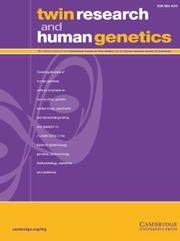Crossref Citations
This article has been cited by the following publications. This list is generated based on data provided by
Crossref.
Magnusson, Patrik K E
Rasmussen, Finn
and
Gyllensten, Ulf B
2006.
Height at age 18 years is a strong predictor of attained education later in life: cohort study of over 950 000 Swedish men.
International Journal of Epidemiology,
Vol. 35,
Issue. 3,
p.
658.
Silventoinen, K.
Posthuma, D.
Van Beijsterveldt, T.
Bartels, M.
and
Boomsma, D. I.
2006.
Genetic contributions to the association between height and intelligence: evidence from Dutch twin data from childhood to middle age.
Genes, Brain and Behavior,
Vol. 5,
Issue. 8,
p.
585.
Case, Anne
and
Paxson, Christina
2008.
Stature and Status: Height, Ability, and Labor Market Outcomes.
Journal of Political Economy,
Vol. 116,
Issue. 3,
p.
499.
Huang, T. L.
Carlson, M. C.
Fitzpatrick, A. L.
Kuller, L. H.
Fried, L. P.
and
Zandi, P. P.
2008.
Knee height and arm span.
Neurology,
Vol. 70,
Issue. 19_part_2,
p.
1818.
Sundet, Jon Martin
Borren, Ingrid
and
Tambs, Kristian
2008.
The Flynn effect is partly caused by changing fertility patterns.
Intelligence,
Vol. 36,
Issue. 3,
p.
183.
Arden, Rosalind
Gottfredson, Linda S.
and
Miller, Geoffrey
2009.
Does a fitness factor contribute to the association between intelligence and health outcomes? Evidence from medical abnormality counts among 3654 US Veterans.
Intelligence,
Vol. 37,
Issue. 6,
p.
581.
Finkel, Deborah
and
Reynolds, Chandra A.
2009.
Handbook of Behavior Genetics.
p.
101.
Flynn, James R.
2009.
Requiem for nutrition as the cause of IQ gains: Raven's gains in Britain 1938–2008.
Economics & Human Biology,
Vol. 7,
Issue. 1,
p.
18.
Black, Sandra E.
Devereux, Paul J.
and
Salvanes, Kjell G.
2010.
Under Pressure? The Effect of Peers on Outcomes of Young Adults.
SSRN Electronic Journal,
Lindqvist, Erik
2010.
Height and Leadership.
SSRN Electronic Journal,
Salvanes, Kjell G.
Carneiro, Pedro Manuel
and
Løken, Katrine Vellesen
2010.
A Flying Start? Long Term Consequences of Maternal Time Investments in Children During Their First Year of Life.
SSRN Electronic Journal,
Case, Anne
and
Paxson, Christina
2010.
Causes and consequences of early-life health.
Demography,
Vol. 47,
Issue. Suppl 1,
p.
S65.
Beauchamp, Jonathan P.
Cesarini, David
Johannesson, Magnus
Lindqvist, Erik
and
Apicella, Coren
2011.
On the sources of the height–intelligence correlation: New insights from a bivariate ACE model with assortative mating.
Behavior Genetics,
Vol. 41,
Issue. 2,
p.
242.
Woodley, Michael A.
2011.
The Cognitive Differentiation-Integration Effort Hypothesis: A Synthesis between the Fitness Indicator and Life History Models of Human Intelligence.
Review of General Psychology,
Vol. 15,
Issue. 3,
p.
228.
Li, Wen-Dong
Arvey, Richard D.
and
Song, Zhaoli
2011.
The influence of general mental ability, self-esteem and family socioeconomic status on leadership role occupancy and leader advancement: The moderating role of gender.
The Leadership Quarterly,
Vol. 22,
Issue. 3,
p.
520.
Bhuller, Manudeep
Mogstad, Magne
and
Salvanes, Kjell G.
2011.
Life-Cycle Bias and the Returns to Schooling in Current and Lifetime Earnings.
SSRN Electronic Journal,
Geher, Glenn
and
Kaufman, Scott Barry
2011.
The Cambridge Handbook of Intelligence.
p.
603.
Black, Sandra
Devereux, Paul J.
and
Salvanes, Kjell G.
2012.
Losing Heart? The Effect of Job Displacement on Health.
SSRN Electronic Journal,
Eriksen, Willy
Sundet, Jon M.
and
Tambs, Kristian
2012.
Twin–Singleton Differences in Intelligence: A Register-Based Birth Cohort Study of Norwegian Males.
Twin Research and Human Genetics,
Vol. 15,
Issue. 5,
p.
649.
Firmin, Michael W.
Hoffman, Sarah J.
Firmin, Ruth L.
Lee, Alisha D.
and
Vorobyov, Yelana
2012.
Tall College Women's Social Dynamics Relating to Height.
Qualitative Research in Psychology,
Vol. 9,
Issue. 3,
p.
210.


